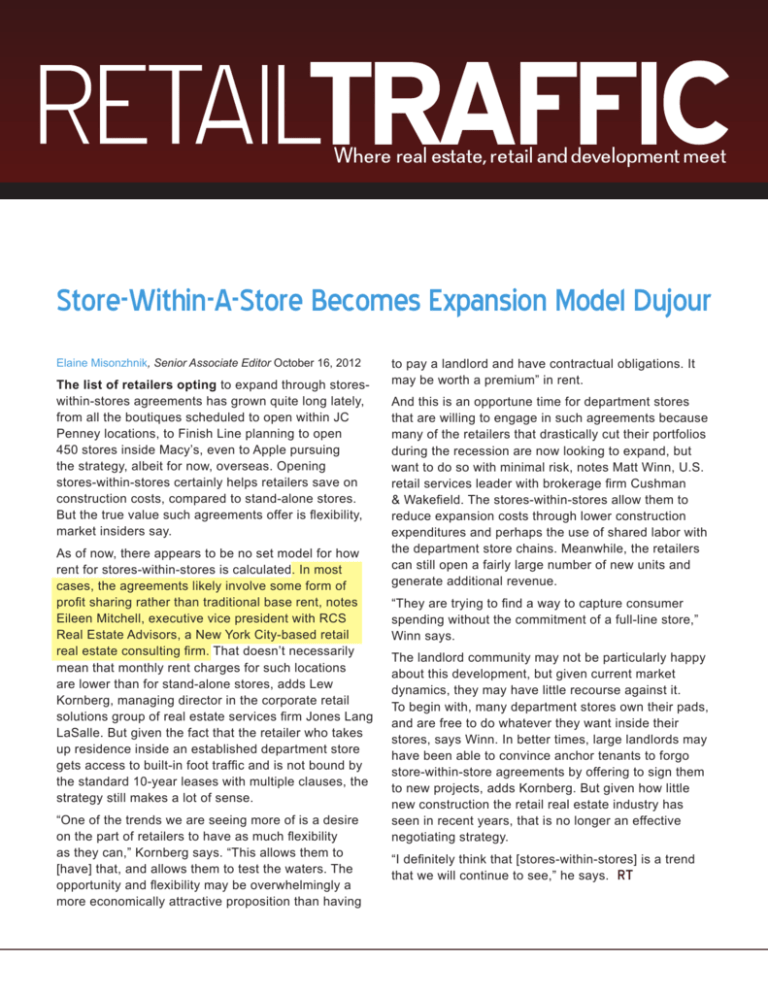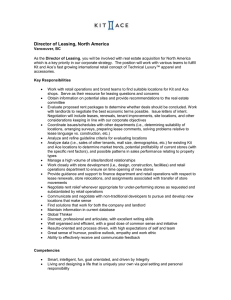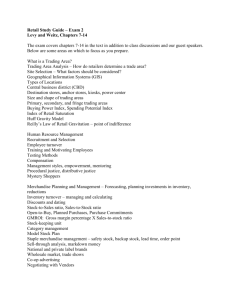Store-Within-A-Store Becomes Expansion Model Dujour
advertisement

Store-Within-A-Store Becomes Expansion Model Dujour Elaine Misonzhnik, Senior Associate Editor October 16, 2012 The list of retailers opting to expand through storeswithin-stores agreements has grown quite long lately, from all the boutiques scheduled to open within JC Penney locations, to Finish Line planning to open 450 stores inside Macy’s, even to Apple pursuing the strategy, albeit for now, overseas. Opening stores-within-stores certainly helps retailers save on construction costs, compared to stand-alone stores. But the true value such agreements offer is flexibility, market insiders say. As of now, there appears to be no set model for how rent for stores-within-stores is calculated. In most cases, the agreements likely involve some form of profit sharing rather than traditional base rent, notes Eileen Mitchell, executive vice president with RCS Real Estate Advisors, a New York City-based retail real estate consulting firm. That doesn’t necessarily mean that monthly rent charges for such locations are lower than for stand-alone stores, adds Lew Kornberg, managing director in the corporate retail solutions group of real estate services firm Jones Lang LaSalle. But given the fact that the retailer who takes up residence inside an established department store gets access to built-in foot traffic and is not bound by the standard 10-year leases with multiple clauses, the strategy still makes a lot of sense. “One of the trends we are seeing more of is a desire on the part of retailers to have as much flexibility as they can,” Kornberg says. “This allows them to [have] that, and allows them to test the waters. The opportunity and flexibility may be overwhelmingly a more economically attractive proposition than having to pay a landlord and have contractual obligations. It may be worth a premium” in rent. And this is an opportune time for department stores that are willing to engage in such agreements because many of the retailers that drastically cut their portfolios during the recession are now looking to expand, but want to do so with minimal risk, notes Matt Winn, U.S. retail services leader with brokerage firm Cushman & Wakefield. The stores-within-stores allow them to reduce expansion costs through lower construction expenditures and perhaps the use of shared labor with the department store chains. Meanwhile, the retailers can still open a fairly large number of new units and generate additional revenue. “They are trying to find a way to capture consumer spending without the commitment of a full-line store,” Winn says. The landlord community may not be particularly happy about this development, but given current market dynamics, they may have little recourse against it. To begin with, many department stores own their pads, and are free to do whatever they want inside their stores, says Winn. In better times, large landlords may have been able to convince anchor tenants to forgo store-within-store agreements by offering to sign them to new projects, adds Kornberg. But given how little new construction the retail real estate industry has seen in recent years, that is no longer an effective negotiating strategy. “I definitely think that [stores-within-stores] is a trend that we will continue to see,” he says. RT






![[DATE] Mary Ziegler Director Division of Regulations, Legislation](http://s3.studylib.net/store/data/007212021_1-b96b03cd98cadfc74a22865c0247494d-300x300.png)




